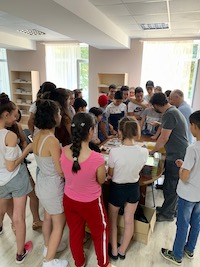Articles

Source: Emma Loosley
Researcher Highlight: Emma Loosley
Routes is currently highlighting the diverse work conducted by our members on issues of migration, mobility and displacement. Here we feature an update from Professor Emma Loosley on her current collaboration with the Georgian National Museum.
Since 2017, we have been working with the Georgian National Museum (GNM) on initiatives to encourage children from disadvantaged backgrounds to engage with cultural heritage and use this as a platform to raise educational aspirations. Georgia has had a series of crises since the end of communism in 1991, suffering a civil war, the loss of Abkhazia and, since 2008 Samachblo/South Ossetia has been occupied by the Russian army. This means that there are up to 232,700 Internally Displaced Persons (IDPs) in Georgia out of a population of 3.9 million, which equates to almost 17% of the overall population of the country. 20% of the country’s territory is occupied by Russia and these factors have placed a significant social, political and economic strain on society. Added to this, the population of Tbilisi is now officially 1,225,000 (although it is believed the real total is higher), and this movement from the villages to the capital has precipitated a crisis in life opportunities for many young people.
As Transcaucasia geographically acts as a land bridge between Europe and Asia, Georgia has also seen growing numbers of refugees, in particular from Syria and Afghanistan, seeking asylum. In Georgia, refugees appear to be largely family units more than the single young men more familiar in Western Europe, and families and children from this community have also attended some of the events we have organised and have enthusiastically engaged with learning about Georgian history and archaeology. As Chinese and Indian immigrants arrive as a result of the ‘belt and road initiative’ and the availability of good agricultural land respectively, there is a rising tension between strongly nationalist elements of society and these new Georgians. Our project uses examples of past diversity in society to encourage more conversations around how ‘Georgianess’ can encompass a variety of identities.
Date: 24 September 2020
